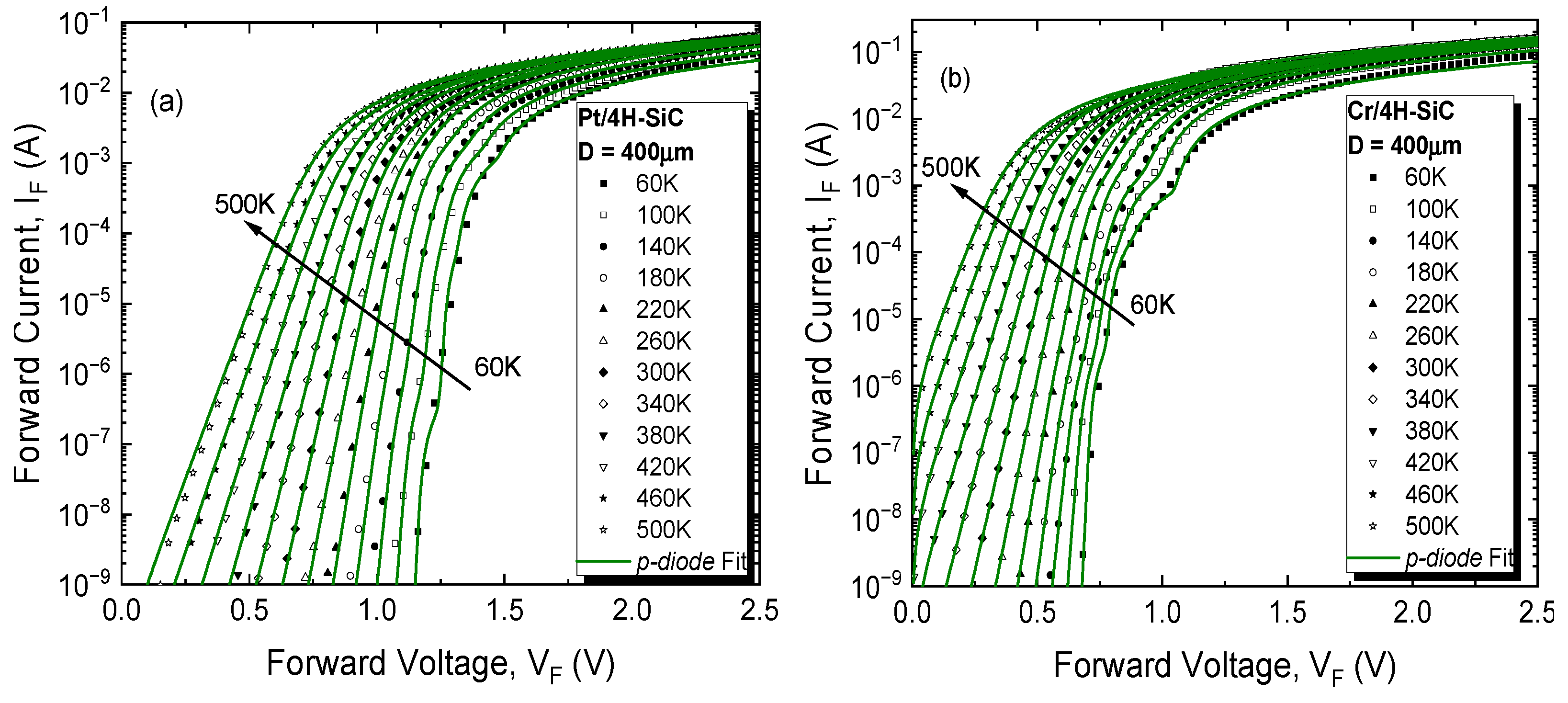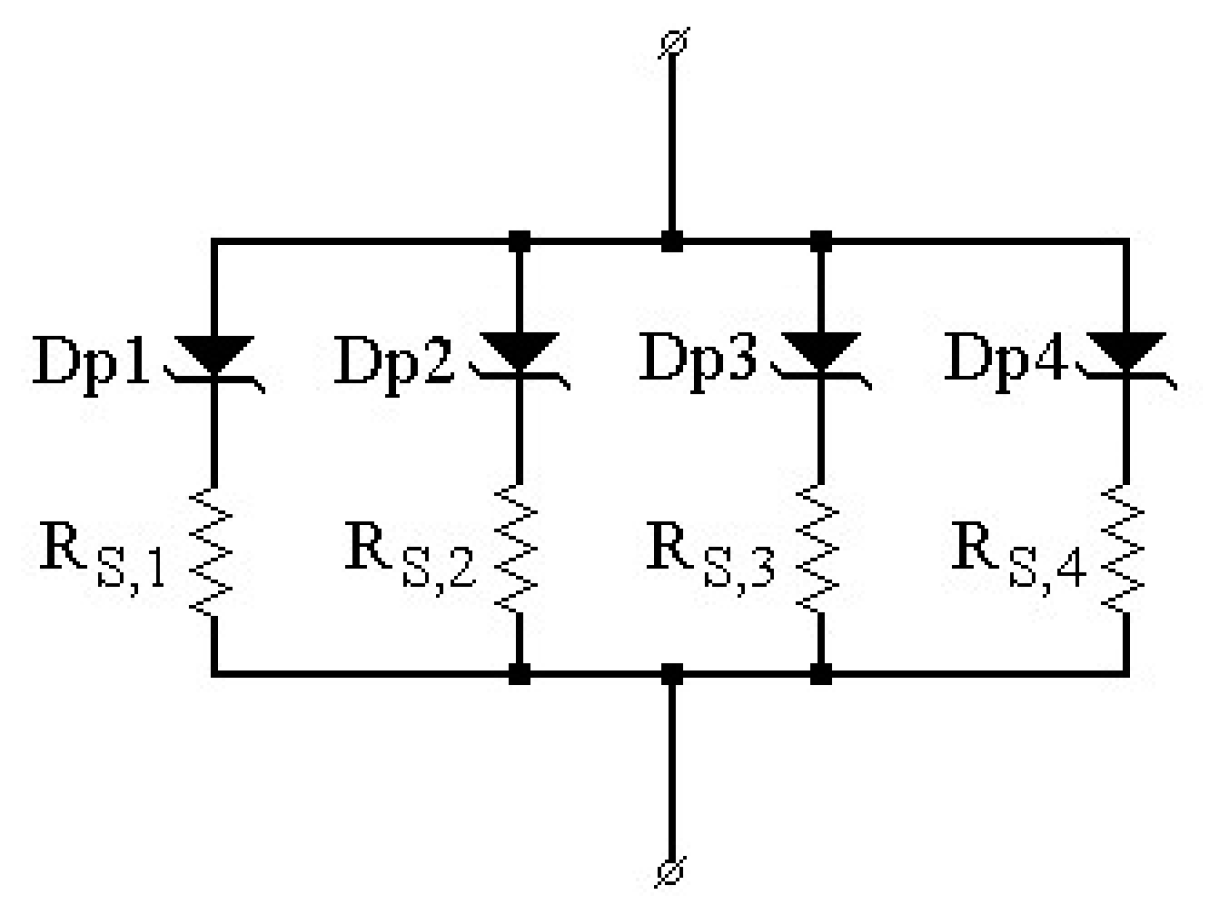Thorough Wide-Temperature-Range Analysis of Pt/SiC and Cr/SiC Schottky Contact Non-Uniformity
Abstract
:1. Introduction
2. Materials and Methods
3. Results
3.1. Microstructural Investigations—X-ray Diffraction and X-ray Photoelectron Spectroscopy Analysis
3.2. Electrical Characterization
3.2.1. Temperature-Dependent Electrical Characteristics
3.2.2. Standard SBD Characterization
3.2.3. State-of-the-Art Contact-Inhomogeneity Analysis
4. Conclusions
Author Contributions
Funding
Data Availability Statement
Conflicts of Interest
References
- Godignon, P.; Jorda, X.; Vellvehi, M.; Perpina, X.; Banu, V.; Lopez, D.; Barbero, J.; Brosselard, P.; Massetti, S. SiC Schottky diodes for harsh environment space applications. IEEE Trans. Ind. Electron. 2011, 58, 2582–2589. [Google Scholar] [CrossRef]
- She, X.; Huang, A.Q.; Lucia, O.; Ozpineci, B. Review of Silicon Carbide Power Devices and Their Applications. IEEE Trans. Ind. Electron. 2017, 64, 8193–8205. [Google Scholar] [CrossRef]
- Draghici, F.; Brezeanu, G.; Pristavu, G.; Pascu, R.; Badila, M.; Pribeanu, A.; Ceuca, E. 400 °C Sensor Based on Ni/4H-SiC Schottky Diode for Reliable Temperature Monitoring in Industrial Environments. Sensors 2019, 19, 2384. [Google Scholar] [CrossRef] [PubMed]
- Somma, R.; Troise, C.; Zeni, L.; Minardo, A.; Fedele, A.; Mirabile, M.; Natale, G. De Long-Term Monitoring with Fiber Optics Distributed Temperature Sensing at Campi Flegrei: The Campi Flegrei Deep Drilling Project. Sensors 2019, 19, 1009. [Google Scholar] [CrossRef] [PubMed]
- Hermans, T.; Nguyen, F.; Robert, T.; Revil, A. Geophysical Methods for Monitoring Temperature Changes in Shallow Low Enthalpy Geothermal Systems. Energies 2014, 7, 5083–5118. [Google Scholar] [CrossRef]
- Qi, J.; Yang, X.; Li, X.; Chen, W.; Tian, K.; Wang, M.; Guo, S.; Yang, M. Comparative Temperature Dependent Evaluation and Analysis of 1.2-kV SiC Power Diodes for Extreme Temperature Applications. IEEE Trans. Power Electron. 2020, 35, 13384–13399. [Google Scholar] [CrossRef]
- Kim, S.; Choi, J.; Jung, M.; Joo, S.; Kim, S. Silicon carbide-based hydrogen gas sensors for high-temperature applications. Sensors 2013, 13, 13575–13583. [Google Scholar] [CrossRef]
- Pascu, R.; Craciunoiu, F.; Pristavu, G.; Brezeanu, G.; Kusko, M. Oxide trap states versus gas sensing in SiC-MOS capacitors—The effect of N- and P- based post oxidation processes. Sens. Actuators B Chem. 2017, 245, 911–922. [Google Scholar] [CrossRef]
- Taylor, N.R.; Yu, Y.; Ji, M.; Aytug, T.; Mahurin, S.; Mayes, R.; Cetiner, S.; Paranthaman, M.P.; Ezell, D.; Cao, L.R.; et al. Thermal and radiation response of 4H-SiC Schottky diodes with direct-write electrical contacts. Appl. Phys. Lett. 2020, 116, 252108. [Google Scholar] [CrossRef]
- Della Corte, F.G.; Pangallo, G.; Rao, S.; Carotenuto, R.; Iero, D.; Merenda, M.; Pezzimenti, F. Use of 4H-SiC-based diodes as temperature sensors. In Proceedings of the 2019 International Semiconductor Conference (CAS), Sinaia, Romania, 9–11 October 2019; pp. 71–74. [Google Scholar] [CrossRef]
- Zhang, N.; Lin, C.; Senesky, D.G.; Pisano, A.P. Temperature sensor based on 4H-silicon carbide pn diode operational from 20 °C to 600 °C. Appl. Phys. Lett. 2014, 104, 073504. [Google Scholar] [CrossRef]
- Rao, S.; Pangallo, G.; Pezzimenti, F.; Corte, F.G.D. High-Performance Temperature Sensor Based on 4H-SiC Schottky Diodes. IEEE Electron Device Lett. 2015, 36, 720–722. [Google Scholar] [CrossRef]
- Lebedev, A.A.; Kozlovski, V.V.; Davydovskaya, K.S.; Levinshtein, M.E. Radiation Hardness of Silicon Carbide upon High-Temperature Electron and Proton Irradiation. Materials 2021, 14, 4976. [Google Scholar] [CrossRef] [PubMed]
- Pascu, R.; Pristavu, G.; Oneata, D.T.; Stoian, M.; Romanitan, C.; Kusko, M.; Draghici, F.; Brezeanu, G. Enhanced Method of Schottky Barrier Diodes Performance Assessment. Rom. J. Inf. Sci. Technol. 2023, 2023, 181–192. [Google Scholar] [CrossRef]
- Li, D.; Li, X.; Chang, G.; Qi, F.; Packwood, M.; Pottage, D.; Wang, Y.; Luo, H.; Dai, X.; Liu, G. Characterization of A 3.3 kV Si—SiC Hybrid Power Module in Half—Bridge Topology for Traction Inverter Application. IEEE Trans. Power Electron. 2020, 35, 13429–13440. [Google Scholar] [CrossRef]
- Kyoung, S.; Jung, E.S.; Sung, M.Y. Post-annealing processes to improve inhomogeneity of Schottky barrier height in Ti/Al 4H-SiC Schottky barrier diode. Microelectron. Eng. 2016, 154, 69–73. [Google Scholar] [CrossRef]
- Bourenane, K.; Keffous, A.; Nezzal, G. Electrical properties of Schottky diode Pt/SiC and Pt/porous SiC performed on highly resistif p-type 6H-SiC. Vacuum 2007, 81, 663–668. [Google Scholar] [CrossRef]
- Saxena, V.; Nong, J.; Steckl, A.J. High-Voltage Ni- And Pt-SiC Schottky Diodes Utilizing Metal Field Plate Termination. IEEE Trans. Electron Devices 1999, 46, 456–464. [Google Scholar] [CrossRef]
- Khanna, S.; Noor, A.R. Electrical Characterization of Chromium/4H-SIC Schottky Barrier Diodes. Int. J. Eng. Sci. Technol. 2010, 2, 220–226. [Google Scholar]
- Strel’Chuk, A.M.; Kalinina, E.V. Schottky diodes based on 4H-SiC epitaxial layers. J. Phys. Conf. Ser. 2021, 2103, 012235. [Google Scholar] [CrossRef]
- Tung, R.T. Recent advances in Schottky barrier concepts. Mater. Sci. Eng. R Rep. 2001, 35, 1–138. [Google Scholar] [CrossRef]
- Kumar, V.; Verma, J.; Maan, A.S.; Akhtar, J. Epitaxial 4H–SiC based Schottky diode temperature sensors in ultra-low current range. Vacuum 2020, 182, 109590. [Google Scholar] [CrossRef]
- Cowley, A.M. Titanium-silicon Schottky barrier diodes. Solid State Electron. 1970, 13, 403–414. [Google Scholar] [CrossRef]
- Brezeanu, G.; Pristavu, G.; Draghici, F.; Pascu, R.; Della Corte, F.; Rascuna, S. Enhanced Non-Uniformity Modeling of 4H-SiC Schottky Diode Characteristics Over Wide High Temperature and Forward Bias Ranges. IEEE J. Electron Devices Soc. 2020, 8, 1339–1344. [Google Scholar] [CrossRef]
- Pascu, R.; Pristavu, G.; Brezeanu, G.; Draghici, F.; Godignon, P.; Romanitan, C.; Serbanescu, M.; Tulbure, A. 60–700 K CTAT and PTAT Temperature Sensors with 4H-SiC Schottky Diodes. Sensors 2021, 21, 942. [Google Scholar] [CrossRef] [PubMed]
- Mazzotta, E.; Rella, S.; Turco, A.; Malitesta, C. XPS in development of chemical sensors. RSC Adv. 2015, 5, 83164–83186. [Google Scholar] [CrossRef]
- Larrieu, G.; Dubois, E.; Wallart, X.; Baie, X. Formation of Pt-based silicide contacts: Kinetics, stochiometry and current drive capabilities. J. Appl. Phys. 2003, 94, 7801–7810. [Google Scholar] [CrossRef]
- Biesinger, M.C.; Payne, B.P. Resolving surface chemical states in XPS analysis of first row transition metals, oxides and hydroxides: Cr, Mn, Fe, Co and Ni. Appl. Surf. Sci. 2011, 257, 2717–2730. [Google Scholar] [CrossRef]
- Gammon, P.M.; Pérez-Tomás, A.; Shah, V.A.; Vavasour, O.; Donchev, E.; Pang, J.S.; Myronov, M.; Fisher, C.A.; Jennings, M.R.; Leadley, D.R.; et al. Modelling the inhomogeneous SiC Schottky interface. J. Appl. Phys. 2013, 114, 223704. [Google Scholar] [CrossRef]
- Sullivan, J.P.; Tung, R.T.; Pinto, M.R.; Graham, W.R. Electron transport of inhomogeneous Schottky barriers: A numerical study. J. Appl. Phys. 1991, 70, 7403–7424. [Google Scholar] [CrossRef]
- Roccaforte, F.; Giannazzo, F.; Alberti, A.; Spera, M.; Cannas, M.; Cora, I.; Pécz, B.; Iucolano, F.; Greco, G. Barrier inhomogeneity in vertical Schottky diodes on free standing gallium nitride. Mater. Sci. Semicond. Process. 2019, 94, 164–170. [Google Scholar] [CrossRef]
- Werner, J.H.; Güttler, H.H. Barrier inhomogeneities at Schottky contacts. J. Appl. Phys. 1991, 69, 1522–1533. [Google Scholar] [CrossRef]
- Gülnahar, M. Temperature dependence of current-and capacitance-voltage characteristics of an Au/4H-SiC Schottky diode. Superlattices Microstruct. 2014, 76, 394–412. [Google Scholar] [CrossRef]
- Gammon, P.M.; Fisher, C.A.; Shah, V.A.; Jennings, M.R.; Pérez-Tomás, A.; Burrows, S.E.; Myronov, M.; Leadley, D.R.; Mawby, P.A. The cryogenic testing and characterisation of SiC diodes. Mater. Sci. Forum 2014, 778–780, 863–866. [Google Scholar] [CrossRef]
- Triendl, F.; Pfusterschmied, G.; Pobegen, G.; Konrath, J.P.; Schmid, U. Theoretical and experimental investigations of barrier height inhomogeneities in poly-Si/4H-SiC heterojunction diodes. Semicond. Sci. Technol. 2020, 35, 115011. [Google Scholar] [CrossRef]
- Pristavu, G.; Brezeanu, G.; Badila, M.; Draghici, F.; Pascu, R.; Craciunoiu, F.; Rusu, I.; Pribeanu, A. Barrier Stability of Pt/4H-SiC Schottky Diodes Used for High Temperature Sensing. Mater. Sci. Forum 2017, 897, 606–609. [Google Scholar] [CrossRef]








| Extracted Parameters | ||||
|---|---|---|---|---|
| Temperature Range, T (K) | Pt/4H-SiC Sample | Cr/4H-SiC Sample | ||
| (V) | σ (V) | (V) | σ (V) | |
| 100–240 | 1.774 | 0.134 | 1.206 | 0.111 |
| 300–500 | 1.544 | 0.088 | 1.163 | 0.089 |
| Sample | Parallel Diodes | ΦBn [V] | n | peff | RS [Ω] |
|---|---|---|---|---|---|
| Pt/4H-SiC | Pt-Dp1 | 1.51 | 1.03 | 0.51 | 44–60 |
| Pt-Dp2 | 1.35 | 3.04 | 150–48 | ||
| Pt-Dp3 | 1.3 | 4.39 | 150–800 | ||
| Pt-Dp4 | 1.21 | 9.26 | 200 k–40 k | ||
| Cr/4H-SiC | Cr-Dp1 | 1.1 | 0.37 | 14.2–21.9 | |
| Cr-Dp2 | 0.93 | 3.73 | 50–430 | ||
| Cr-Dp3 | 0.8 | 10.98 | 300–550 | ||
| Cr-Dp4 | 0.73 | 13.39 | ~15 k |
Disclaimer/Publisher’s Note: The statements, opinions and data contained in all publications are solely those of the individual author(s) and contributor(s) and not of MDPI and/or the editor(s). MDPI and/or the editor(s) disclaim responsibility for any injury to people or property resulting from any ideas, methods, instructions or products referred to in the content. |
© 2024 by the authors. Licensee MDPI, Basel, Switzerland. This article is an open access article distributed under the terms and conditions of the Creative Commons Attribution (CC BY) license (https://creativecommons.org/licenses/by/4.0/).
Share and Cite
Pascu, R.; Pristavu, G.; Oneata, D.-T.; Brezeanu, G.; Romanitan, C.; Djourelov, N.; Enache, A.; Draghici, F.; Ivan, A.M.; Ceuca, E. Thorough Wide-Temperature-Range Analysis of Pt/SiC and Cr/SiC Schottky Contact Non-Uniformity. Materials 2024, 17, 400. https://doi.org/10.3390/ma17020400
Pascu R, Pristavu G, Oneata D-T, Brezeanu G, Romanitan C, Djourelov N, Enache A, Draghici F, Ivan AM, Ceuca E. Thorough Wide-Temperature-Range Analysis of Pt/SiC and Cr/SiC Schottky Contact Non-Uniformity. Materials. 2024; 17(2):400. https://doi.org/10.3390/ma17020400
Chicago/Turabian StylePascu, Razvan, Gheorghe Pristavu, Dan-Theodor Oneata, Gheorghe Brezeanu, Cosmin Romanitan, Nikolay Djourelov, Andrei Enache, Florin Draghici, Andrei Mario Ivan, and Emilian Ceuca. 2024. "Thorough Wide-Temperature-Range Analysis of Pt/SiC and Cr/SiC Schottky Contact Non-Uniformity" Materials 17, no. 2: 400. https://doi.org/10.3390/ma17020400
APA StylePascu, R., Pristavu, G., Oneata, D.-T., Brezeanu, G., Romanitan, C., Djourelov, N., Enache, A., Draghici, F., Ivan, A. M., & Ceuca, E. (2024). Thorough Wide-Temperature-Range Analysis of Pt/SiC and Cr/SiC Schottky Contact Non-Uniformity. Materials, 17(2), 400. https://doi.org/10.3390/ma17020400










